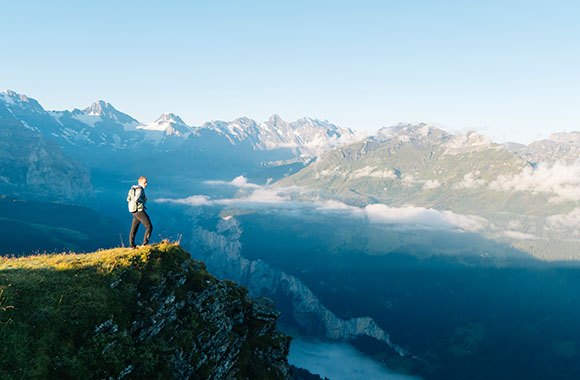Preparing for a hike: Planning a hiking route and hiking training
Not only do unique nature experiences await you on hikes, the physical challenge is also one of the attractions of hiking. To enjoy your excursion and reach your destination safely, every hike must be well planned: from choosing the right hiking route to the meal planning. The longer and more extensive your planned hike, the more you need to consider. Make sure you take enough time for planning and preparation before you actually set off on a multi-day hike.
Whether you are a hiking novice or already have experience with smaller walks and day hikes, multi-day hikes are a completely new challenge. We collect tips on how to plan and prepare a hike, and give you information on how to organise your hiking training.

Table of contents
Planning a hiking route: How to find the right hiking trail
For your hiking tour to be a great experience, planning is essential. Evaluate every possible hiking route according to difficulty, technical demands, and risks. Make sure you pay attention to the following factors, among others:
- Level of difficulty of the hike: route, altitude difference, time required, possible climbing passages
- Technical requirements: steady footing, no fear of heights, good hiking gear
- Weather conditions: rain, sunshine, cold, storms, snow, fog, or mud
- Condition of the terrain
- Condition of the paths and signs
- Opening and seasonal times for inns, cable cars, etc.
- Bus and train connections
Especially for longer and/or more demanding routes, it is always wise to plan alternative routes and options to cut the walk short.
For beginners, it is advisable to choose a hike that suits your own abilities and knowledge. If you are an experienced hiker and are looking for new challenges, it is possible to set yourself a fixed goal and train accordingly to reach it. Examples are walking a long-distance hiking trail such as the Camino de Santiago or even climbing a mountain.
For beginners, it is advisable to choose a hike that suits your own abilities and knowledge. If you are an experienced hiker and are looking for new challenges, it is possible to set yourself a fixed goal and train accordingly to reach it. Examples are walking a long-distance hiking trail such as the Camino de Santiago or even climbing a mountain.
What conditions are important when planning a hike?
Which hike is right for you depends on various factors:
- Who will be hiking with you?
- How long should the hike be?
- Where will you stay overnight and what will you eat?
First of all, the composition of the hiking group has a great influence on the choice of tour (e.g. barrier-free hiking trails or themed and educational hiking trails). For all hikes, it is important to realistically assess the abilities and physical condition of the participating hikers. If you are hiking in a group, you should always orient yourself towards the least experienced hiker. This is especially true if you want to hike with children.

Set clear goals for yourself. Do you want to spend a more leisurely hiking holiday on flat terrain, or do you want to try a challenging mountain hike? For beginners, it is advisable to choose tours that are manageable. Go for hikes that are a little below the skill level you currently have. This applies to all hikers, regardless of whether they set out alone, in pairs or in a group. Keep in mind that more extreme long-distance hikes require not only a solid physical condition but also mental stamina.
Whether you are planning a hut tour, hiking from place to place or camping, you should always book an accommodation or reserve a place at your planned stops in good time. Check out shopping opportunities where you can stock up on supplies. Your stage destinations will determine how much food you need to pack.
In addition to classic hiking guides, more and more outdoor enthusiasts are using internet services such as Outdooractive or komoot. Always check whether the information is up to date. You should assess whether the description of the tour is detailed enough for you and whether the walking time and level of difficulty are suitable for your abilities. In addition, you should have different navigation options at hand: e.g. different hiking maps and a compass and/or a smartphone with GPS.
In addition to classic hiking guides, more and more outdoor enthusiasts are using internet services such as Outdooractive or komoot. Always check whether the information is up to date. You should assess whether the description of the tour is detailed enough for you and whether the walking time and level of difficulty are suitable for your abilities. In addition, you should have different navigation options at hand: e.g. different hiking maps and a compass and/or a smartphone with GPS.
How to calculate the duration of a hike?
A decisive factor in tour planning is time planning. To create a realistic schedule, you need to be able to estimate how much distance you can cover in a certain amount of time. Formulas for calculating walking time help you to estimate the time required. These formulas are based on empirical values, which are then set as a norm.
Here is a ground rule for distances that the average hiker can cover in one hour:
- 300 metres of altitude uphill
- 500 metres of altitude downhill
- 4 kilometres horizontally
If you would like to use this standard as a guide, you can calculate the walking time for your planned tour. The walking time calculator also takes into account changes to the above-mentioned assessment basis, e.g. if you take short breaks: https://www.wanderndeluxe.de/
When hiking with children, the walking time is longer, depending on the age of the child. You can follow the rule of thumb: walking time with children = 1.5 x normal walking time for adults.
When planning your hike, you should consider that rest and meal breaks are added to the pure walking time. It is also advisable to always plan a time buffer, because not every hiker follows the “set” walking pace and not every hike goes as planned. With time reserves, you can also react to sudden changes in the weather.
In the Alpine region, the difficulty levels of mountain trails are marked differently in the various countries. You can find an overview here: https://www.bergfreunde.eu/
In the Alpine region, the difficulty levels of mountain trails are marked differently in the various countries. You can find an overview here: https://www.bergfreunde.eu/
Preparing for a hike: The right training for a hiking tour
Hiking as a sport has several health benefits: It is considered an endurance sport that is easy on the joints, gentle and challenging at the same time. Nevertheless, good physical preparation for the hike is just as important as planning and equipment. The best way to train for a hike depends on various factors: for example, how often you do sport in general, how extensive your planned hike is and how long you want to be able to complete the hike. So that you don’t overexert yourself, especially on a long-distance hike, it’s best to start training well in advance.
As a beginner, for example, you can train for hiking like this:
- Start with short hikes. As a beginner, start with 5 kilometres and work your way up to 10 to 15 kilometres. Slowly adjust the difficulty of the terrain and the length of the hike to your abilities.
- Start at a moderate walking speed. Don’t try to push yourself to your limits very quickly. On flat terrain, the average hiker walks about 4 to 5 kilometres per hour, although the time will naturally increase for ascents and descents. For beginners, 2.5 to 3 kilometres per hour is a good start.

- As walking is a social activity for many people, there is a good rule of thumb for the pace: if you can still chat without getting out of breath, your walking speed is abought right.
- To train for a hike, you should improve your endurance and build up strength. Train regularly and slowly increase the intensity of your training.
- Increase your endurance with sports such as swimming, cycling, or jogging. When jogging, it is advisable to run on soft ground (e.g. forest floor). It is best to include sections with a slight incline.
- If you walk on different stony or uneven ground, you can train your balance and steady footing at the same time.
- Since hiking uses a wide variety of muscles that you may not use as much in everyday life, it is essential to train your legs, buttocks, hips, back and shoulders.
If you are planning a demanding trekking tour or long-distance hike, you should start training 3 to 6 months in advance to prepare your body for the upcoming effort. If you are a complete hiking novice, it is advisable to start building up your endurance and fitness 6 to 9 months in advance.
Conclusion
Between choosing the right hiking route and training, a lot of planning time is needed, especially for multi-day hikes. To ensure that you are physically and mentally prepared for a longer hike, it is essential to prepare as early as possible. Choose a hike that suits your level of knowledge and your abilities and then prepare yourself specifically for it. The more experience you gain with hiking, the greater the challenges you can expect. With thorough planning and preparation, you can guarantee that you will arrive at your destination safe and sound. And once you’re there you can enjoy the happiness of having mastered an eventful and challenging hike.
References:
https://adventures.com/
(Accessed on 13.10.2021)
https://www.bergfreunde.eu/
(Accessed on 13.10.2021)
https://www.trailhiking.com.au/
(Accessed on 13.10.2021)
https://www.globaladventurechallenges.com/
(Accessed on 13.10.2021)
Image sources:
iStock.com/Julian Dewert
iStock.com/Delmaine Donson
iStock.com/svetikd
iStock.com/microgen




